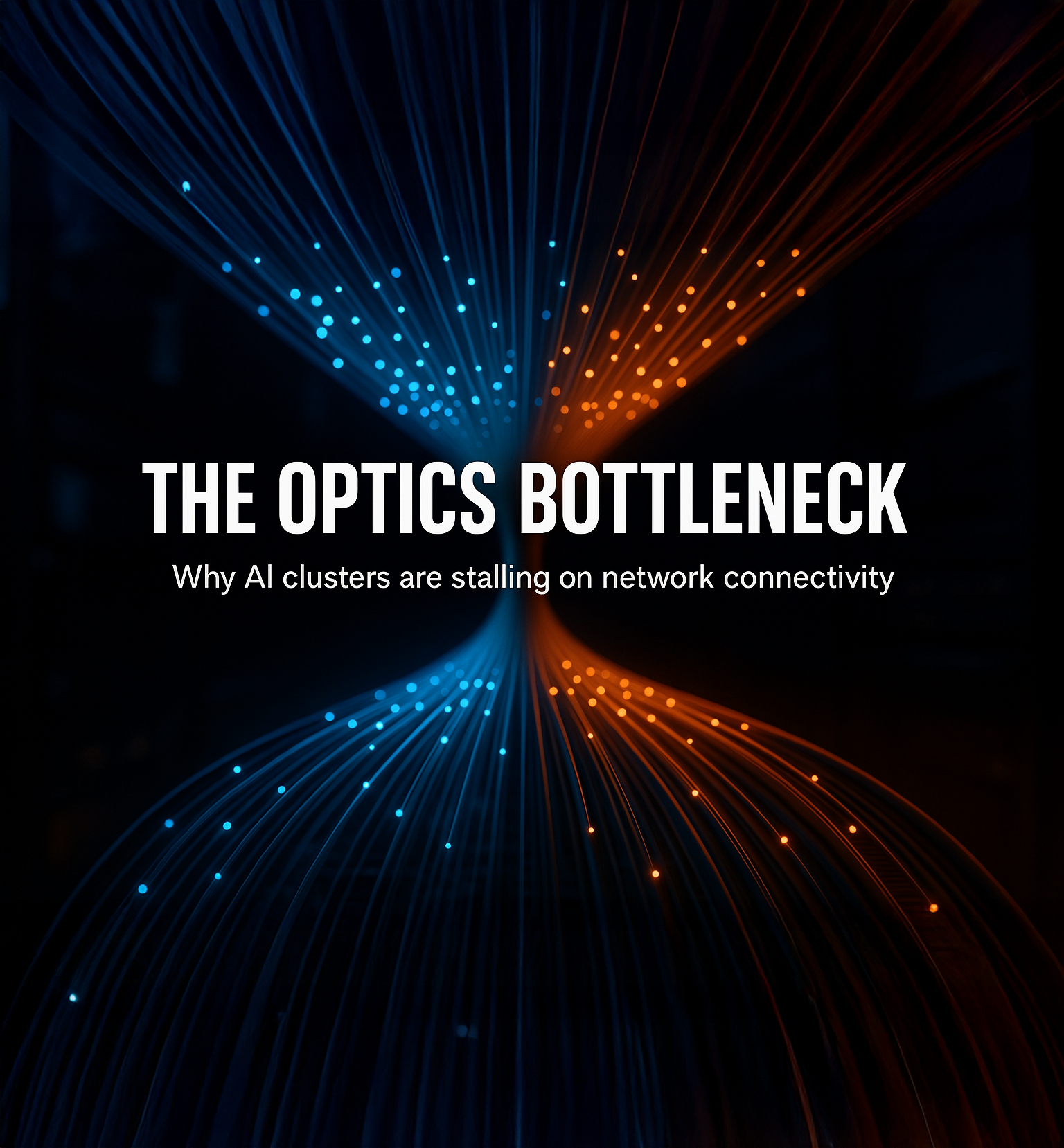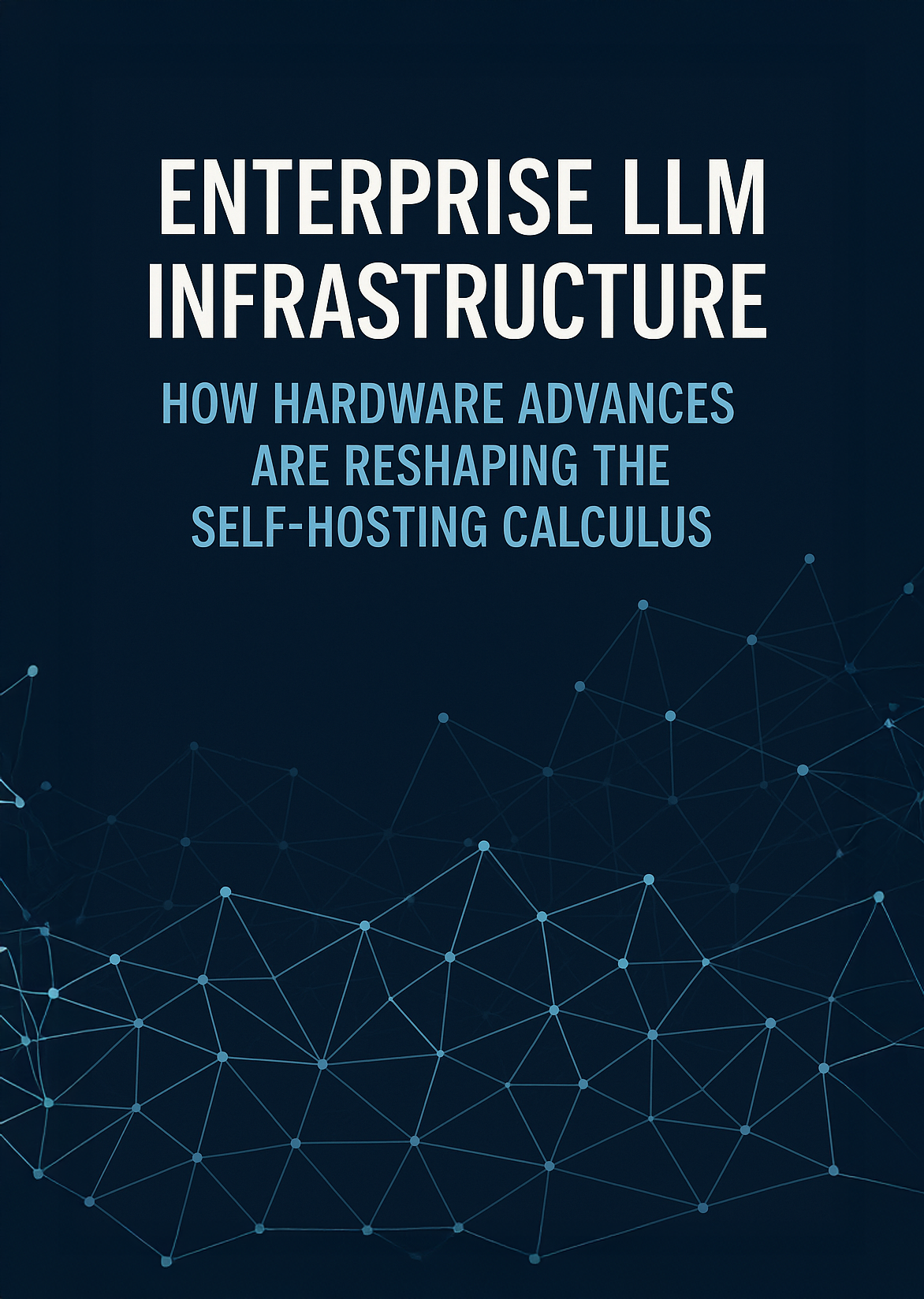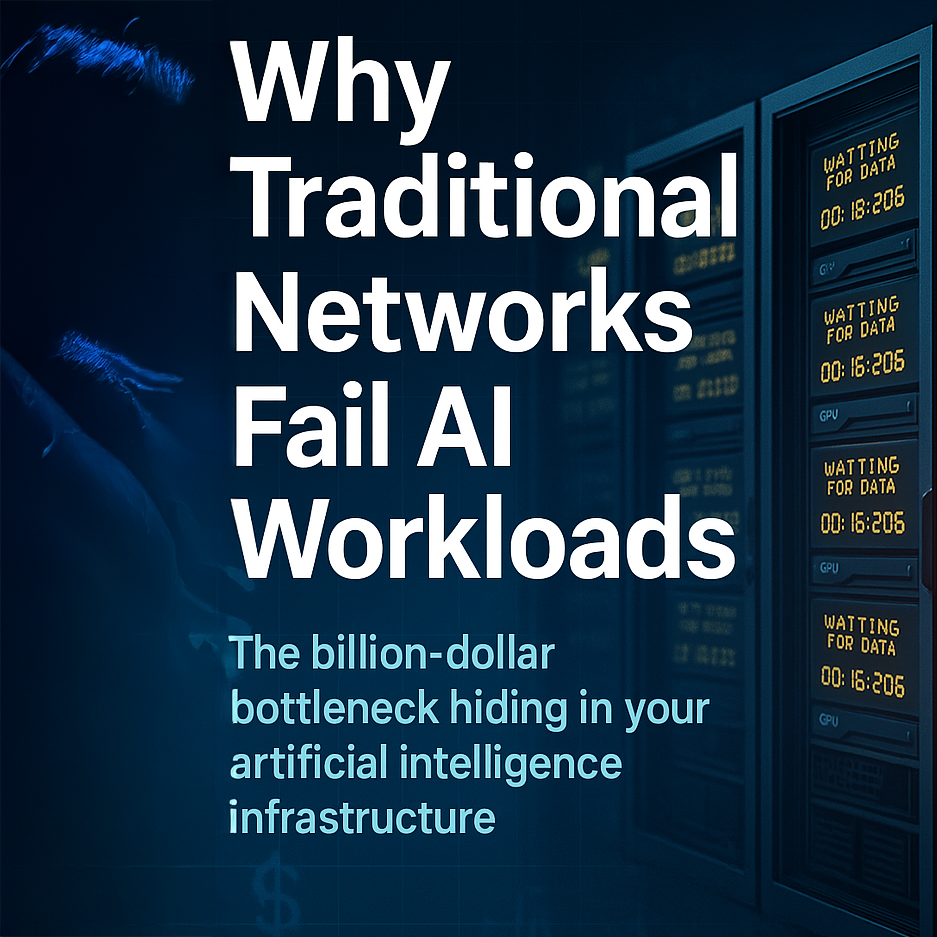Enterprise AI Models: How Hardware Advances Are Reshaping the Self-Hosting Calculus
Cohere's recent $6.8 billion valuation signals something interesting about enterprise AI preferences, but not quite what you might expect. While...
8 min read
![]() Art Fewell
:
Aug 6, 2025 12:55:55 AM
Art Fewell
:
Aug 6, 2025 12:55:55 AM

Bottom Line Up Front: The supply chain crisis in high-speed ethernet transceivers has forced organizations building AI clusters into technical decision-making they've never had to master. Understanding encoding schemes, channel configurations, and compatibility matrices has shifted from "nice to know" to "project-critical" almost overnight.
Your new GPU cluster has finally arrived. Two years of waiting, millions in investment, and your team is ready to deploy the AI infrastructure that will define your organization's next decade. But there's a problem that blindsided everyone: the 800GbE and 400GbE transceivers needed to network these systems are backordered for another six months.
This scenario has become the norm, not the exception. The same supply chain dynamics that created GPU shortages have cascaded into the optical transceiver market, hitting high-speed optics (400G+) particularly hard. Organizations that historically relied on networking vendors to provide simple, pre-approved parts lists now find themselves navigating a complex third-party market—often without the technical background to avoid expensive mistakes.
The fundamental shift: What was once vendor-managed selection has become customer-managed technical decision-making. And the learning curve is steep.
In the traditional networking world, vendors provided carefully curated compatibility lists. Cisco would tell you exactly which SFP+ modules worked with which switches. Arista would provide a short list of certified optics for each platform. Customers made purchasing decisions from pre-tested, guaranteed-compatible options.
The AI infrastructure boom shattered this model. Demand for high-speed transceivers outstripped curated supply chains, and extended lead times forced organizations into the third-party optics market. But here's the challenge: third-party suppliers have never had to cater to non-specialists. Their websites assume you understand the difference between DR1, DR2, and DR4 encoding, or why a QSFP-DD connector doesn't guarantee compatibility across different channel configurations.
What makes this crisis particularly challenging: In modern high-speed networking, transceivers typically represent 60-80% of the total per-port cost. This represents a fundamental shift from traditional networking where ports were essentially "included" in the switch price. When components that expensive become unavailable through normal channels, organizations face enormous economic pressure to find alternatives quickly—often without the technical expertise to avoid costly mistakes.
For organizations building AI clusters, this creates a perfect storm: urgent timelines, unfamiliar technology, suppliers who assume expertise you may not have, and economic stakes that make mistakes extremely expensive.
Let's ground this in specifics. Consider a 128-node GPU cluster built around B200 or Mi300X accelerators:
The hidden complexity: Each connection decision involves understanding distance limitations, encoding compatibility, channel configurations, and form factor requirements. Miss any one element, and expensive transceivers become expensive paperweights.
Start with what seems simple: cable distances. In traditional top-of-rack designs, distances were predictable. However, AI clusters require rail-optimized cabling that extends connections across multiple racks, creating variable distances that directly impact transceiver selection.
Direct Attached Cables (DACs) remain the preferred option when distance permits—they're reliable, cost-effective, and eliminate compatibility guesswork. But AI cluster layouts push many connections beyond DAC reach, forcing you into the complex world of separate transceivers.
The breakout cable challenge: Your 800GbE switch port needs to split into two 400GbE server connections. With DAC breakouts, the split location determines reach patterns in ways most vendors don't clearly document. A 5-meter cable might reach both servers or neither, depending on where the fork occurs in the cable.
Here's where technical knowledge becomes critical. Modern high-speed transceivers use different encoding schemes that must match on both ends of every connection:
NRZ (Non-Return-to-Zero): Simpler, lower power, shorter reach
PAM4 (Pulse Amplitude Modulation): More complex, higher power, longer reach
Critical rule: You cannot mix encoding schemes, even at the same speed. A PAM4 transceiver will not communicate with an NRZ transceiver, regardless of what your speed negotiations suggest.
This is where many organizations encounter expensive surprises. A 400GbE transceiver might use:
Real-world scenario: You purchase NICs capable of both 400GbE and 200GbE for flexibility. At 400GbE, the NIC expects DR4 transceivers. At 200GbE, it expects DR2. You find available DR8 transceivers in the market—they're 400GbE, they physically fit, they negotiate the right speed, but they fail to establish stable connections because the channel count doesn't match what the NIC expects.
This type of mismatch is becoming increasingly common as organizations source from multiple suppliers to meet availability requirements.
Physical connector types add another complexity layer. The same QSFP-DD connector might support:
Each configuration requires different transceiver types, and your switch configuration determines which is expected. The connector tells you nothing about compatibility.
Modern small form factor pluggable (QSFP) variants have evolved to support multiple speeds and configurations, but this flexibility creates complexity in compatibility verification.
Before diving into technical specifications, address the most critical question: How will you get support when something goes wrong?
Most networking vendors fall into one of these categories regarding third-party optics:
The universal rule: No major networking vendor provides support for uncertified third-party optics. When you purchase non-certified transceivers, you're trading cost savings and availability against support coverage.
This creates a fundamental risk calculation: Is the cost difference worth potentially being on your own if issues arise? For mission-critical AI infrastructure, this question deserves serious consideration.
Traditional networking vendors maintain extensive compatibility testing. Third-party suppliers often provide basic specification sheets and expect customers to verify compatibility. This isn't because they're unhelpful—it's because their traditional customers (hyperscalers, service providers) have dedicated optics specialists.
Key evaluation criteria when working with third-party suppliers:
High-speed transceivers often have 12-26 week lead times, and availability varies dramatically by specific configuration. Strategic planning requires understanding:
Here's a fundamental shift that most organizations haven't fully grasped: In modern high-speed networking, transceivers often cost more than the switches themselves.
Traditional networking evolved when switches came with built-in copper ports. A 48-port gigabit switch included all the connectivity you needed in the base price. Modern high-speed switches at 100GbE and above often ship as empty chassis with transceiver slots that you must populate separately.
The new math: Transceivers now typically represent 60-80% of the total per-port cost, fundamentally inverting traditional cost assumptions. Yet most organizations still evaluate switches as if the switch were the expensive component, treating optics as an afterthought.
Traditional networking vendors typically offer single-source certified optics at premium pricing. This creates two challenges for AI infrastructure deployment:
These economic realities are driving organizations toward alternative procurement strategies, particularly as AI cluster deployments involve hundreds or thousands of high-speed connections.
Traditional approach: Select switches first, then source required optics
Modern approach: Evaluate optics costs and availability as part of switch vendor selection
This paradigm shift matters because different vendor ecosystems offer dramatically different optics economics:
Traditional enterprise vendors typically provide limited certified optics lists with premium pricing but comprehensive support. Whitebox switching vendors generally maintain certified compatibility lists for multiple third-party optics manufacturers, offering:
For organizations deploying large-scale AI infrastructure, the total cost difference between these approaches can be substantial—potentially millions of dollars for large deployments.
High-speed transceivers consume significant power:
In a 1,000-port AI cluster, transceiver power consumption alone can exceed 15-20kW, requiring dedicated cooling consideration in rack power and thermal design.
Your transceiver choices drive long-term infrastructure investments:
The infrastructure decisions you make today will impact expansion options and migration costs for years.
Before purchasing any transceivers:
Diversification strategies:
Building internal capability:
Several factors suggest transceiver selection complexity will remain challenging:
Organizations building AI infrastructure face fundamental choices that extend beyond technical specifications:
Vendor Ecosystem Selection:
Internal Capability Development:
Leveraging specialized expertise: For organizations focused on rapid deployment, partnering with teams experienced in navigating these optical networking challenges can eliminate much of this complexity. Hedgehog specializes in exactly these scenarios, handling transceiver selection and sourcing complexities so organizations can focus on their AI initiatives rather than optical networking intricacies. The open-source platform and free virtual lab provide hands-on experience with modern kubernetes-native networking approaches.
The critical insight: Optics are no longer an afterthought in networking procurement. They're often the largest cost component and should drive vendor selection decisions accordingly.
The transceiver selection landscape has fundamentally shifted from vendor-managed simplicity to customer-managed technical complexity. Understanding encoding schemes, channel configurations, form factors, supply chain dynamics, and vendor support models has become essential for successful AI cluster deployment.
The economic insight: Modern networking procurement must evolve to treat transceivers as the major cost component they've become, not as an afterthought to switch selection. Organizations that continue to evaluate networking infrastructure using traditional approaches will face significant cost and availability challenges.
The strategic insight: This isn't a temporary market condition that will resolve with better supply chains. The combination of rapid technology evolution, diverse supplier ecosystems, increasing performance requirements, and evolving vendor support models means transceiver selection complexity is here to stay.
For organizations focused on rapid AI infrastructure deployment, success requires either developing significant internal optical networking expertise or partnering with teams that possess this knowledge. The cost of getting transceiver selection wrong—in terms of project delays, support gaps, performance issues, or compatibility failures—far exceeds the investment in proper expertise and strategic vendor selection.
The bottom line: Modern AI infrastructure success increasingly depends on mastering technical and economic complexities that most organizations have never had to consider. Those who adapt their procurement practices and technical capabilities to this new reality will deploy faster, more cost-effectively, and more reliably than those who don't.
Navigating the technical complexity of modern AI networking requires deep expertise in rapidly evolving technologies. Hedgehog's kubernetes-native networking platform abstracts these complexities while delivering the performance and scale that AI workloads demand, allowing organizations to focus on their AI initiatives rather than optical networking intricacies.

Cohere's recent $6.8 billion valuation signals something interesting about enterprise AI preferences, but not quite what you might expect. While...

Why Traditional Networks Fail AI Workloads The billion-dollar bottleneck hiding in your artificial intelligence infrastructure

Dell'Oro Group just released their 4Q 2024 Ethernet Switch - Data Center Report showing record-breaking sales fueled by AI buildouts and a recovery...